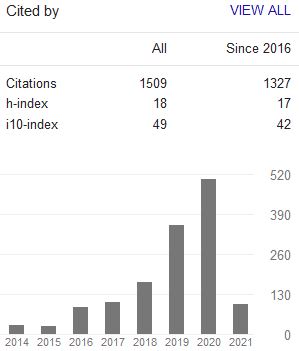FILMING AYAT-AYAT CINTA: The Making of a Muslim Public Sphere in Indonesia
Abstract
Keywords
Full Text:
PDFReferences
Albrow, Martin. Max Weber’s Construction of Social Theory, New York: St. Martin’s press, 1990.
Böttcher, Annablle. “Religious Authority in Transnational Sufi Networks: Shaykh Nāzim al-Qubrusi al-Haqqanī.” in Krämer, Gudrun and sabine Schmidtke (eds). Speaking for Islam: Religious Authorities in Muslim Societies. Leiden: Brill, 2006, pp.241-268.
Burhanuddin, Jajat. “The Fragmentation of Religious Authority: Islamic Print Media in Early 20th Century Indonesia.” Studia Islamika 11:1 (2004), pp. 23-62.
Hirschkind, Charles. “Cassette Ethics: Public Piety and Popular Media in Egypt.” in Birgit Meyer and Annelies Moors (eds). Religion, Media, and the Public Sphere. Bloomington and Indianapolis: Indiana University Press, 2006, pp. 29-51.
Eickelman, Dale F. and John W. Anderson (eds). New Media in the Muslim World: The Emerging Public Sphere. Bloomington and Indianapolis: Indiana University Press, 1999.
Eickelman, Dale. F. and Armando Salvatore. “The Public Sphere and Muslim Identities.” European Journal of Sociology 43 (2002): pp. 96-115.
El-Shirazy, Habiburrahman. Ayat-ayat Cinta: Sebuah Novel Pembangun Jiwa. Jakarta: Republika Press and Pesantren Karya Basmala, 2004.
Farihah, Ipah and Heriyanto. Pandangan Masyarakat Terhadap Poligami dan Dampaknya Terhadap Keluarga. Jakarta: UIN Jakarta Press, 2007.
Gaborieau, Marc. The Redefinition of Religious Authority among South Asian Muslim from 1919 to 1956. Conference Paper. Bogor, July 2005.
Habermas, Jürgen. The Structural Transformation of the Public Sphere. Cambridge: Polity Press, 2008.
Haryadi, Rohmat. Saat Bioskop Jadi Majelis Taklim: Sihir Film Ayat-ayat Cinta. Jakarta: Penerbit Hikmah, 2008.
Heider, Karl G. Indonesian Cinema: National Culture on Screen. Honolulu: University of Hawaii Press, 1991.
Hoexter, Miriam., Shmuel N. Eisenstadt and Nehemia Levtzion (eds). The Public Sphere in Muslim Society. New York: State University of New York Press, 2002.
Hornby, A S. Oxford Advanced Learners Dictionary of Current English. 4th Edition. Oxford: Oxford University Press, 1989.
Humprheys, R. Stephen. Islamic History: A Framework for Inquiry. London - New York: I.B. Tauris & Co. Ltd, 1991.
Kaptein, Nico J.G. “The Voice of the ‘Ulama: Fatwas and Religious Authority in Indonesia.” Archives de Sciences Sociales des Religions 125 (Janiver-mars 2004): p. 115-130.
Krämer, Gudrun and Sabine Schmidtke (eds). Speaking for Islam: Religious Authorities in Muslim Societies. Leiden: Brill, 2006.
Messcik, Brinkley. The Calligraphic State: Textual Domination and History in a Muslim Society. Berkeley: University of California Press, 1993.
Meyer, Birgit and Annelies Moors (eds.). Religion, Media, and the Public Sphere. Bloomington and Indianapolis: Indiana University Press, 2006.
Mulia, Siti Musdah. Islam Menggugat Poligami. Jakarta: Gramedia, 2004.
Plate, S. Brent. “The Footprints of Film: After Images of Religion in American Space and Time.” in Jolyon Mithell and S. Brent Plate (eds). The Religion and Film Reader. New York and London: Routledge, 2007.
Salvatore, Armando & Dale F. Eickelman (ed.). Public Islam and the Common Good. Leiden: Brill, 2004.
Sasono, Eric. ”Dua Tahun Transisi Perfilman Indonesia: Catatan untuk Tahun 2005-2007.” in J.B. Kristanto. Katalog Film Indonesia 1926-2007. Jakarta: Penerbit Nalar, 2007.
Warner, Michael. “Publics and Counterpublics.” Public Culture 14:1 (2002), p 49-90.
Zaman, Muhammad Qasim. The Ulama in Contemporary Islam: Custodian of Change. Princeton and Oxford: Princeton University Press, 2002.
Films
Ayat-ayat Cinta
Berbagi Suami
Newspapers
Kompas
Republika
Sabili
Electronic Sources
www.detiknews.com
www.dearestmask.blog.friendster.com
www.youtube.com
www.thejakartapost.com
www.achmadarifin.wordpress.com
www.eramuslim.com
www.liputan6.com
www.kompas.com
DOI: 10.15642/JIIS.2010.4.1.43-61
Refbacks
- There are currently no refbacks.
Indexed by:
Journal of Indonesian Islam (ISSN 1978-6301 and E-ISSN 2355-6994) is published by the Postgraduate Program (PPs) and the Institute for the Study of Religion and Society (LSAS), State Islamic University (UIN) of Sunan Ampel Surabaya.
Journal of Indonesian Islam by http://jiis.uinsby.ac.id/index.php/JIIs/index is licensed under a Creative Commons Attribution-ShareAlike 4.0 International License.
Copyright ©2020 State Islamic University (UIN) of Sunan Ampel Surabaya. Powered by Public Knowledge Project OJS.







